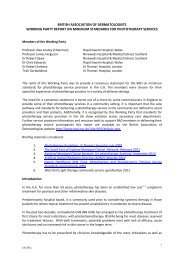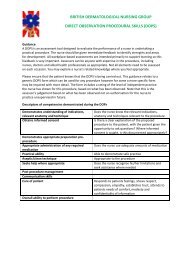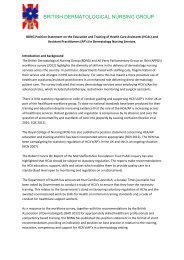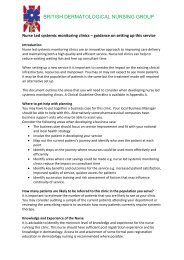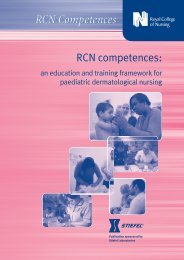Improving outcomes for people with skin tumours including melanoma
Improving outcomes for people with skin tumours including melanoma
Improving outcomes for people with skin tumours including melanoma
You also want an ePaper? Increase the reach of your titles
YUMPU automatically turns print PDFs into web optimized ePapers that Google loves.
<strong>Improving</strong> Outcomes <strong>for</strong><br />
People <strong>with</strong> Skin Tumours<br />
<strong>including</strong> Melanoma<br />
Initial investigation,<br />
diagnosis, staging and<br />
management<br />
Box 1. Clinical guidelines <strong>for</strong> primary care on the management<br />
of <strong>skin</strong> cancer and precancerous lesions (see definitions of<br />
types of lesion in ‘Glossary of terms’, Appendix 6)<br />
1. Patients <strong>with</strong> pigmented <strong>skin</strong> lesions<br />
Patients who present to their GP <strong>with</strong> pigmented <strong>skin</strong> lesions need careful<br />
assessment <strong>with</strong> a full history and examination of the <strong>skin</strong> lesion being<br />
recorded. If the lesion is thought to be benign the patient may be reassured;<br />
however, it is strongly recommended that all such patients should be provided<br />
<strong>with</strong> both oral and written in<strong>for</strong>mation regarding the changes that may<br />
subsequently suggest malignant trans<strong>for</strong>mation and instructed to return if any<br />
such changes occur or if the lesion continues to concern the patient. If there is<br />
any doubt about the lesion, or if there is a history of recent change, the patient<br />
should be referred urgently to a specialist who is a member of the<br />
LSMDT/SSMDT <strong>for</strong> further assessment (see below).<br />
4<br />
2. Patients <strong>with</strong> lesions suspicious of <strong>melanoma</strong> or SCC<br />
All patients, where there is a possibility of a <strong>melanoma</strong> or an SCC of the <strong>skin</strong>,<br />
should be referred urgently (consistent <strong>with</strong> national targets and the NICE<br />
Referral guidelines <strong>for</strong> suspected cancer – see chapter on ‘Patient-centred care’),<br />
to a specialist who is a member of the LSMDT/SSMDT, usually to the local<br />
dermatology department rapid access <strong>skin</strong> cancer clinic or pigmented lesion<br />
clinic. Ideally these should be ‘one-stop’ diagnostic and treatment clinics, i.e.<br />
where a diagnosis is made and treatment given in the same clinical session. In<br />
some areas such clinics are arranged by plastic surgery units. If a GP or a doctor<br />
working in the community who belongs to an LSMDT/SSMDT takes an<br />
excisional or incisional biopsy of a lesion that is reported as a <strong>melanoma</strong> or<br />
SCC, the patient should be referred urgently to a specialist who is a member of<br />
the hospital LSMDT/SSMDT.<br />
3. Patients <strong>with</strong> BCC<br />
Where a patient has a lesion that may be a low-risk BCC, he or she may be<br />
referred either to the local hospital specialist who is a member of the<br />
LSMDT/SSMDT, normally a dermatologist, or to a doctor working in the<br />
community who is a member of an LSMDT/SSMDT. Those <strong>with</strong> recurrent and<br />
high-risk lesions should be treated by a hospital specialist who is a member of the<br />
LSMDT/SSMDT. If the referring GP is uncertain whether or not the lesion is a<br />
high- or low-risk BCC, the patient should be referred to a hospital specialist.<br />
Patients <strong>with</strong> BCCs are excluded from current cancer target times in England.<br />
However, the Welsh Cancer Standards <strong>for</strong> <strong>skin</strong> cancer suggest that patients should<br />
not wait more than 5 months from receipt of the GP referral letter at the hospital<br />
be<strong>for</strong>e starting their definitive treatment. Waiting time targets in England <strong>for</strong> all<br />
outpatient appointments will mean that from 2007 no patient will wait more than<br />
18 weeks be<strong>for</strong>e being seen. Improvements in waiting time are desirable.<br />
4. Patients <strong>with</strong> precancerous <strong>skin</strong> lesions<br />
Precancerous <strong>skin</strong> lesions such as actinic/solar keratoses (AKs) or in situ SCC of<br />
the <strong>skin</strong> (Bowen’s disease) are common, and the GP may treat these using one<br />
of the recognised treatments (e.g. cryotherapy, topical drug treatments, curettage<br />
and cautery). The patient may also be referred to a doctor working in the<br />
community who is a member of an LSMDT/SSMDT or the local dermatology<br />
department. If the lesions are hypertrophic or inflamed or if there is any other<br />
reason to suspect that they may have developed into an SCC, the patient should<br />
be referred to a dermatologist who belongs to the LSMDT/SSMDT.<br />
5. Uncertain diagnosis<br />
If the GP is uncertain of the diagnosis the patient should be referred <strong>for</strong> further<br />
assessment to a dermatologist who is a member of an LSMDT/SSMDT.<br />
78<br />
National Institute <strong>for</strong> Health and Clinical Excellence




